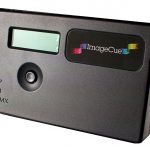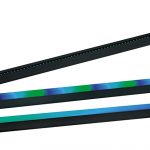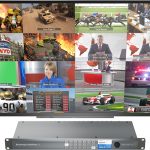Nothing wrong here, just more points of potential failure and more gear to buy. Why not make all your connection points on the box? Well, there’s a real estate issue when you consider all the different types of plugs in use today.
There was a time when the promise of a single, unified connector was oh-so-close…(read HDMI?) but that never really came about. We’re closer with SDI, but until then, we’ll have to adapt. Or use one of the LiveCore™ series switchers from Analog Way.
The LiveCore series consists of six switchers, all based on the same robust platform. I was lucky enough to get my hands on the Ascender 48-4K, their top-of-the-line box. The series includes a number of capable switchers — Ascender 48, Ascender 32, Ascender 16, SmartMatriX Ultra, NeXtage 16 and NeXtage 08. All have 8-12 seamless inputs with various combinations of input plugs, with the Ascender 48 featuring a whopping 42 input plugs. The Ascender 48 has four outputs with five output plugs each, plus a dedicated monitoring output.
Around the Unit
The Ascender 48-4K is a 4RU switcher that is heavy duty, rugged and well styled. It features a heavy-duty, reinforced metal chassis that offers rigidity and heavy shock resistance. Its cooling system is optimized to allow for maximum airflow, and it’s fitted with a remote temperature monitoring system. The front and back panels are well protected by rails and feature smooth, curved surfaces with lots of cutouts for airflow. This thing has something like 24 fans in it, so it’s a liiiitttle loud (please give it a bunch of space in the rack!). The rear connection panel is daunting at first — 42 input plugs on 12 inputs! The combinations include HDMI (4K included), DVI-D/Dual link, Displayport and 3G/HD/SD-SDI, along with universal analog on D-sub HD15 as well as DVI-A. So much for using add-on mini converters. If you can’t get a source into this switcher, I’d be surprised. Test patterns are available to ease identification of all inputs and outputs.
Speaking of outputs, the Ascender 48-4K has four, with eight universal analog, four DVI, four 3G/HD-SDI and four SFP optical fiber cages. “Additive modularity,” the ability to link up to two units with inputs and outputs shared and added, is the key when you consider the amount of output display options you can come up with. You can also synchronize two, three or four units for control with a Vertige™ Controller, and the possibilities are endless. Multiscreen blends, PIPs, flying effects, preview monitoring, confidence monitoring…it’s all here. Four USBs, frame lock and Ethernet round out the back.
The front panel features a color TFT screen allowing setup and access to all functions. There’s a jog wheel with buttons that makes navigation and selection quite easy. There are banks of well-lit soft-touch buttons for output, layer/source selection and control (freeze, Take and logo). These are the style of button without a noticeable “click,” but it will flash to let you know what was pressed. Careful with those thumbs!
Lots of Options, but How’s the Switch?
The LiveCore platform is based on independent layer management, with each source having a native background for live or still images. All layers are uniform, so they can be fully re-sized. On the Ascender 48-4K, there is an upgrade kit for “Perspective Layers,” meaning you can control the depth and three-axis rotation for a more 3D look to PIPs and sources, if that’s your thing. Frames and logos can be stored in 100 memories that can be imported/exported and thumbnailed for easy drag-and-drop. Features like A/B switching, T-bars and “Cut and Fill” are abundant throughout. In addition, a full range of motion-based transitions can be created on the fly.
And all that switch capability is not just reserved for the front buttons. Analog Way’s WebRCS control software is run through your favorite web browser, and is quite robust. It’s a very well-designed interface, with access to all of the functions of the hardware, and then some. There are three separate modes of operation — Setup, Live and Edit.
Setup is where you can take care of all input and output recognition, signal types, screen modes, etc. Live…well, it’s Live mode. You get a global view of all your screens and destinations. Edit is mainly for working on individual screens, but all have snapshot capability.
There’s also customizable dedicated monitoring setup complete with presets. I think the most valuable benefit is multiple users. Up to five different users can access the WebRCS via laptop or tablet — something that could make a really complex setup quite easy (or frustrating, depending on how well the crew gets along).
Anyone who has set up a multi-screen blend knows there can be some complications, from projector placement to software overlap to which monitor is doing what. With the customizable monitoring on the Ascender 48, you can set up a single monitor to be screen confidence instead of using multiple monitors. You could use this for a presenter, or for backstage, or even get a clean record from it. Since all the presets, transitions and configurations are easily recorded and exported, you could theoretically pre-viz and rehearse a very complex show on one coast and save on rental by getting the gear on the other.
There’s a pretty impressive list of add-ons and custom order gear as well. There’s a Secure Power Unit with the same frame design allowing for backup and up to 10 minutes of operation during mains failure. There’s a really cool “Shot Box” — a backlit 76-key keyboard that allows you to recall master presets, screen presets and monitoring layouts prepared with the WebRCS. Of course, there’s an app — the AW Toolbox, available for Android or IOS. You can adjust all the output settings and get right next to the screen on that giant 200-foot-wide blend, so leave the binoculars at home!
There’re also LiveCore Output Expanders, which provide four more outputs and a Monitoring out. I mentioned the Vertige event controller earlier, and it basically gives you a control surface for large events in addition to control for media servers and matrix routers. Analog Way also offers heavy integration with Crestron and AMX drivers for the permanent install crowd, although the Ascender 48 seems to be built more for the live event folks.
Summing Up
All in all, the Ascender 48-4K is an extremely capable switcher. I’m a “hardware and button” kind of guy, and I found myself never even touching the front panel, which is a little unnerving. It’s more than sufficient at very complex AV presentations, and it could serve as a good backbone for an event company looking to get into a more lucrative end of the market. Like any piece of gear that does a LOT, there’s going to be a learning curve, and some training might be required — I don’t know that I’d throw it at a beginner and expect to get decent results. Analog Way offers two levels of certified training if you choose that route.
 At a Glance
At a Glance
Top-of-the-Line, Full Featured Switcher
The Ascender 48-4K tops Analog Way’s six-model LiveCore series of switchers, all of which share a robust platform. With 42 input plugs, it offers ample interconnectivity. Another big bonus: the ability to synchronize two, three or four units for control with a Vertige Controller, and LiveCore’s WebRCS remote control web software.
Ascender 48-4K
PROS:
Well-built, capable multi-format switcher. WebRCS is great.
CONS:
A little complex with setup, soft keys
MSRP: $79,900
Analog Way’s LiveCore Series:
- Ascender 48-4K
- Ascender 32
- Ascender 16
- SmartMatriX Ultra
- NeXtage 16
- NeXtage 08.
More Info: www.analogway.com



